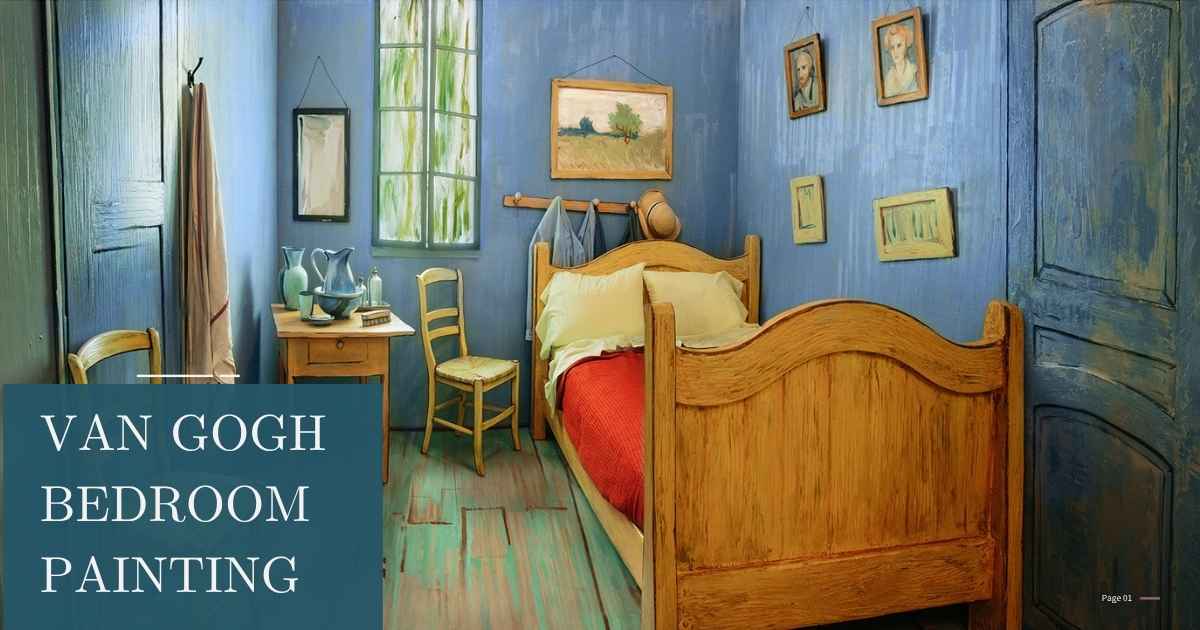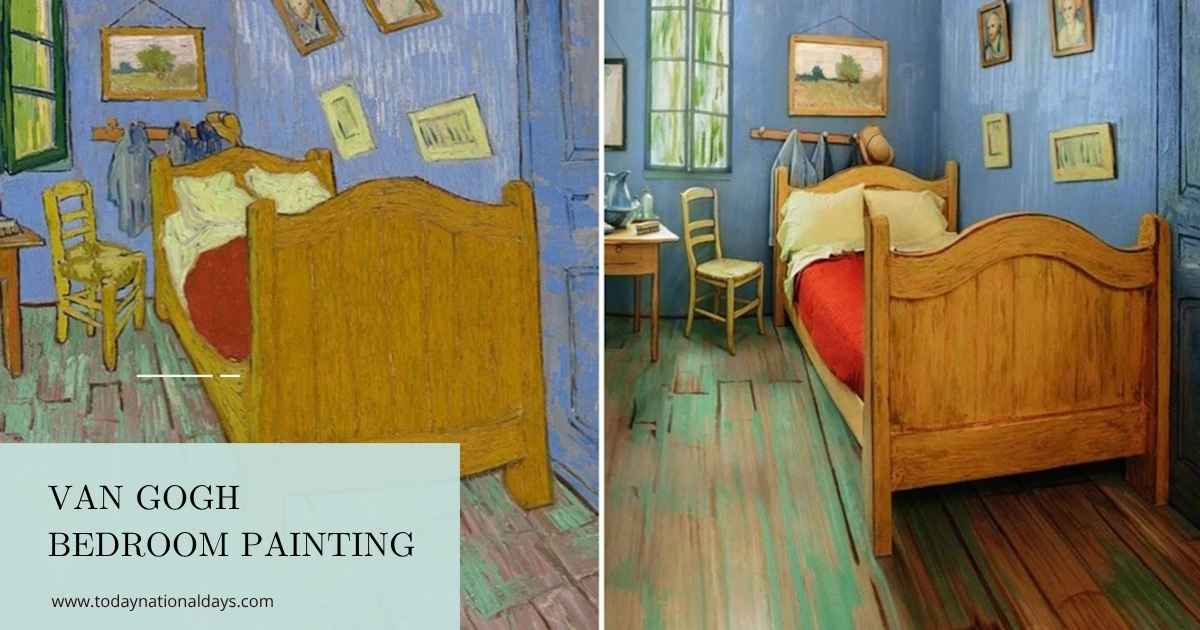
Van Gogh Bedroom stands as one of the most iconic representations of interior space in Western art, painted by the Dutch master Vincent van Gogh during his stay in Arles. This work is deeply personal and reflects Van Gogh’s psychological state, his affection for simplicity, and his search for artistic peace. Today, it’s studied widely across art institutions in countries such as the UK, where students examine its spatial expression and symbolic depth.
The Bedroom series includes three different versions, painted between 1888 and 1889, each reflecting subtle changes in Van Gogh’s emotional and physical condition. This blog explores the visual elements, historical context, and technical aspects of the painting, while also providing detailed analysis to support students, art professionals, and Van Gogh admirers alike.
Top Elements That Define Van Gogh’s Bedroom Masterpiece
The composition of Van Gogh Bedroom may appear simple, yet it holds layered meanings and masterful decisions in its layout, color usage, and symbolism. Each element, from the furniture to the wall hangings, contributes to a unique artistic atmosphere. The painting goes beyond decorative value to become a visual diary of the artist’s emotional world.
- Color and Emotional Symbolism
Van Gogh intentionally used a warm, contrasting palette of red, blue, yellow, and green to create a calming yet vivid environment. Instead of realism, he favored bold tones to reflect emotional stability, isolation, and longing for rest. - Perspective and Spatial Illusion
The distorted perspective is a deliberate artistic decision. While the lines seem to clash and the floor appears tilted, this composition communicates an uneasy balance—perhaps reflecting Van Gogh’s mental state. The room does not follow academic rules but instead creates a feeling of personal space closing in. - Everyday Objects as Personal Symbols
Items such as the bed, chairs, and portraits are not merely props. The two chairs may represent companionship, the bed a desire for rest, and the wall art links to Van Gogh’s connection with others like Paul Gauguin. Each object carries emotional weight beyond its practical use.
Van Gogh’s mastery lies not only in brushwork or color theory but in using domestic simplicity to communicate personal emotion with clarity and intensity.
Table: Comparison of the Three Versions of Van Gogh’s Bedroom
| Feature | First Version (1888) | Second Version (1889) | Third Version (1889) |
|---|---|---|---|
| Location | Van Gogh Museum, Amsterdam | Art Institute of Chicago | Musée d’Orsay, Paris |
| Size | 72 × 90 cm | Slightly smaller | Same as second version |
| Mood and Color Vibrancy | Original emotional intensity | Slightly more balanced | Brighter and cleaner hues |
| Purpose | Personal work | Replica for family | Replica for exhibition |
| Differences in Details | Authentic and raw | Slight edits to perspective | Decorative finishing touches |
Artistic Techniques That Shaped the Bedroom Painting
Van Gogh’s Bedroom series is not only significant because of what it shows, but also because of how it’s painted. His unique approach to brushwork, composition, and material selection helped shape the final look of the series, influencing generations of artists that followed.
1. Brushwork and Texture
Van Gogh’s brush strokes are thick and directional, often following the contours of the objects they represent. The visible texture gives the painting a tactile presence, something digital reproductions cannot fully capture. This impasto technique allowed him to add motion and intensity to otherwise static objects like the bed or walls.
2. Color Blocking and Contrast
Rather than shading for realism, Van Gogh used blocks of color to define shape and emotion. This approach broke from academic standards and aligned with the Post-Impressionist movement. The contrast between the orange wood of the bed and the light blue walls reflects his intent to show peace without dullness.
3. Symbolic Composition
Everything in the composition is laid out to communicate mood and mental state. The rigid verticals and diagonals suggest control but are softened by curves and imprecision. This stylistic inconsistency pulls the viewer into a dreamlike experience, connecting emotionally without requiring realism.
Each artistic decision in the painting is intentional and rooted in Van Gogh’s inner world, making the piece an exemplary study of personal expression through form.
Best Cultural and Psychological Interpretations of Van Gogh’s Bedroom

Van Gogh’s Bedroom in Arles is not merely a painting of a room—it has been subject to various cultural, psychological, and even medical interpretations. Its emotional weight has intrigued art critics, psychologists, and curators alike.
Personal Space and Mental Wellness
Art scholars have linked the painting to Van Gogh’s deteriorating mental health. He sought comfort in creating an idealized space. His time in Arles was marked by instability, yet the Bedroom painting attempts to show peace, which makes its uneven lines and clashing perspective more poignant.
Cultural Reflection of Solitude
The emptiness of the room—no books, no people—speaks volumes. In a UK context, where art therapy is increasingly popular, Van Gogh’s painting is often referenced as a visual case study for loneliness, simplicity, and the yearning for emotional clarity. The work serves as a universal image of solitude.
Artistic Statement Against Industrial Complexity
In the late 19th century, industrialization was transforming European cities. Van Gogh’s simple room rejects urban complexity in favor of rural peace and introspection. The aesthetic choice to leave the space uncluttered reflects a return to basics—an early commentary on minimalism before it became an art movement.
This multi-dimensional interpretation keeps the painting alive in contemporary discussions, proving that Van Gogh’s vision remains globally resonant.
Modern Influences and Replications of Van Gogh’s Bedroom
Van Gogh’s Bedroom has not only remained a popular topic in academic and artistic circles but has also influenced modern media, design, and museum experiences across the world.
Reproductions in Popular Culture
From wall murals to fashion and film, the painting’s layout and colors have been mimicked and modernized. For instance, several museums—including the Art Institute of Chicago—have built life-size 3D replicas of the room for immersive exhibitions, drawing large audiences who want to “step into” the artwork.
Home Decor and Interior Design
Designers often borrow Van Gogh’s palette to create tranquil yet warm bedroom spaces. The combination of sky blues, mustard yellows, and rust reds has become a thematic inspiration for modern boho and vintage interiors.
Influence on Modern Art Installations
Contemporary artists reference the Van Gogh Bedroom to symbolize isolation or psychological struggle. Its simplified lines and emotional resonance make it a prime subject for reinterpretation, particularly in installation art and digital animation.
Its global influence, from museums in Canada to interior design trends in Australia, shows that Van Gogh’s bedroom transcends time, medium, and culture.
How Van Gogh’s Bedroom Reflects Post-Impressionist Ideals
Vincent van Gogh’s Bedroom is a prime example of Post-Impressionism, a movement that emphasized emotional depth and symbolic content over realistic representation. Unlike Impressionists who focused on light and natural scenes, Post-Impressionists sought to express inner feelings and abstract ideas through color and form.
Van Gogh’s use of vivid, unnatural colors and skewed perspective breaks traditional rules but conveys his personal experience of space and mood. The flat planes of color and simplified shapes illustrate his focus on subjective reality rather than objective accuracy. His brushwork is energetic and tactile, further communicating emotional intensity.
This painting exemplifies how Post-Impressionists used visual distortion as a tool to connect viewers with the artist’s mindset, inviting contemplation beyond surface appearances.
Tips for Art Students Learning from Van Gogh Bedroom

Students studying Van Gogh Bedroom can gain much by focusing on both technique and thematic elements. Here are some practical tips:
- Practice Expressive Color Use
Experiment with bold, contrasting colors to convey mood rather than replicate reality. - Study Composition Beyond Realism
Notice how Van Gogh’s tilted floor and exaggerated lines create emotional tension and intimacy. - Explore Texture Through Brushwork
Try thick, directional strokes that add movement and depth to flat surfaces. - Interpret Symbolism
Consider everyday objects as carriers of meaning and narrative rather than mere decoration. - Create Personal Spaces
Use your own environment as inspiration, focusing on emotional resonance rather than photographic accuracy.
By applying these approaches, art students can better understand the power of personal expression in painting, inspired by Van Gogh’s Bedroom.
Final Thoughts on Studying Van Gogh’s Bedroom Painting
Van Gogh’s Bedroom in Arles continues to captivate audiences not because of its technical perfection, but because of its raw honesty. The painting gives a window into the artist’s soul, revealing more through color, space, and simplicity than complex compositions often manage.
Its influence across museums in Canada, universities in the UK, and design studios globally confirms its enduring power. Whether you’re an art student, interior designer, or passionate observer, Van Gogh’s Bedroom remains a masterpiece worth studying, contemplating, and revisiting.
FAQ About Van Gogh’s Bedroom Painting
Why did Van Gogh paint his bedroom multiple times?
He painted three versions—first for himself, then two reproductions to share with family and for potential exhibition purposes.
Where is the original painting located?
The first version is housed at the Van Gogh Museum in Amsterdam.
What is the significance of the two chairs in the painting?
Some believe the chairs reflect Van Gogh and Gauguin’s relationship or Van Gogh’s hope for companionship.
Are the colors realistic?
No. Van Gogh deliberately altered colors to reflect mood rather than physical accuracy.
Why is the perspective distorted in the painting?
The skewed perspective was a stylistic choice to reflect emotional imbalance or to create a dream-like setting.






